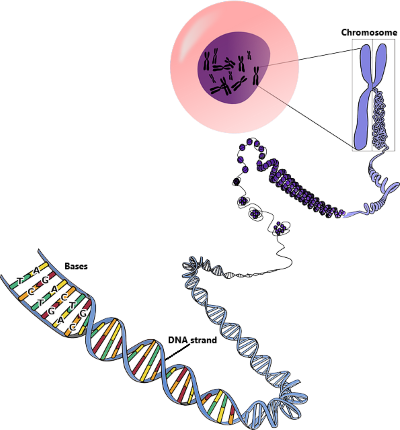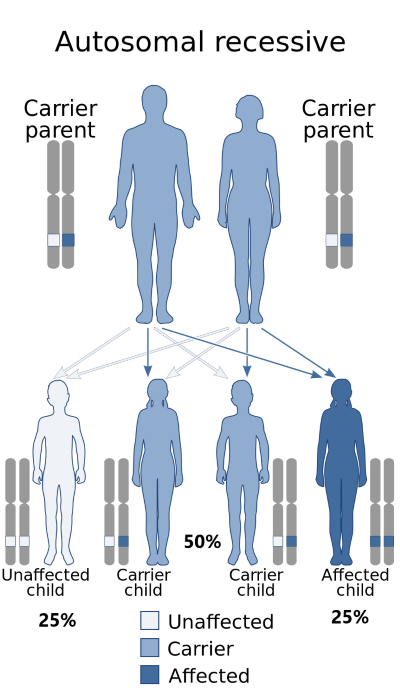What is a genetic disorder?
Published Dec 5, 2020 • By Doriany Samair
To date, more than 8000 genetic disorders have been identified worldwide, and it is estimated that more than than 300 million people live with a genetic disorder across the globe. For the most part, these genetic diseases are rare and often little known. Their common characteristic is an anomaly at genome level (the set of genes), and unlike some diseases, they are not contagious.
What is a genetic disorder? What is a hereditary disease? How are they passed on? How are they diagnosed? What are some of the potential downsides of genetic screening? Let us explain everything in our article!

What is a genetic disorder?
A genetic disorder is an illness caused by an abnormality in a gene or DNA, or in a chromosome of a patient.
DNA (Deoxyribonucleic Acid) is an individual's biological identity and is identical in all the cells of our body (except for red blood cells). It is a molecule that carries an individual's genetic heritage. It exists in the form of strands coiled in a double helix and compacted into chromosomes. The human genome is thus divided into 46 chromosomes (22 pairs of 'autosomes' and one pair of sex chromosomes, 'X and Y'). A DNA sequence corresponds to a gene, which has a very precise location on a chromosome and determines a specific characteristic (such as eye or hair color, for example).

Figure 1: DNA
Source: Adapted from the National Human Genome Research Institute
There are different types of genetic disorders:
- Those caused by a chromosomal abnormality (an excessive number of chromosomes, such as in Down's syndrome, also known as trisomy 21, or the absence of a chromosome in a pair, such as monosomy);
- Those due to a DNA abnormality (or mutation) in one or more genes. DNA mutations can occur in one gene (monogenic disease) or in several genes (polygenic disease) and can cause the body to malfunction.
It is important to know that a DNA anomaly or mutation does not always lead to a genetic disorder, these mutations can go unnoticed and ultimately contribute to genetic variability and diversity.
How are genetic disorders passed along?
The transmission of genetic disorders is conditioned. A genetic disorder is by definition written into an individual's genetic make-up and is passed on to descendants, but not systematically. In fact, the distribution of genetic characteristics during fertilization is random, so for each pair of chromosomes, one chromosome comes from the mother and the other from the father. There are two types of inheritance patterns for non-sex chromosomes (autosomes): autosomal dominant inheritance and autosomal recessive inheritance.
Autosomal recessive inheritance
In this case, an individual can carry the defective gene, but he or she may not express the disorder: a single copy of the gene is not enough for the condition to develop. A person who can pass on a copy of the gene to his or her offspring, but who has not developed the disorder, is called a "carrier". One needs to have two copies of the gene in order to develop the disease, meaning one copy from the mother and one from the father.

Figure 2: Autosomal recessive inheritance
Source: Adapted from Wikimedia Commons
For example, cystic fibrosis, Charcot-Marie-Tooth disease and sickle cell disease are all autosomal recessive disorders.
Autosomal dominant inheritance
In this case, carrying the defective gene necessarily implies expressing the disorder: a single copy is sufficient for the disease to develop. An individual is "affected" and necessarily passes on a copy of the gene to his or her offspring. This means that either the father or the mother, or both, must be affected by the same disease for a person to be ill.

Figure 3: autosomal dominant inheritance
Source: Adapted from Wikimedia Commons
For example achondroplasia (a form of dwarfism), polydactylyism (having additional toes) and Huntingon's disease (a neurodegenerative disease) are autosomal dominant diseases.
X-linked inheritance
Some diseases are passed along through the sex-chromosomes. These X-linked disorders affect men.
A little reminder: the male gender is characterized by a pair of X/Y sex chromosomes and the female gender is characterized by a pair of X/X sex chromosomes. Consequently, an anomaly on the X chromosome in men cannot be corrected as they only have one X chromosome. It should be noted that a father cannot pass this type of condition along to his son (he inevitably passes the Y chromosome along). Women can be healthy carriers because the defective copy of the recessive gene is counterbalanced by the 'healthy' copy on the other X chromosome.
For example, color blindness, Duchenne muscular dystrophy (DMD) and hemophilia are X-linked disorders.
Other cases
Some genetic disorders are caused by "acquired" DNA mutations that are not inherited but occur spontaneously. One example of this are mutations that lead to cancer. These types of mutations, if they affect sex cells, can be passed on to descendants, which is why family health history is so important in making a medical diagnosis.
How are genetic disorders diagnosed?
Screening at birth
Prenatal testing can be performed during pregnancy in the US if there is an increased risk that the baby will have a genetic or chromosomal disorder. These tests can indicate if the fetus is at risk of having a genetic conditions, but require a diagnostic test to determine presence of specific condition and cannot identify all possible inherited disorders.
For certain genetic disorders, screening is systematic: for example, newborn screening is used just after birth to identify genetic disorders that can be treated early in life. All states currently test infants for phenylketonuria (a disorder can cause intellectual disability if left untreated) and congenital hypothyroidism (a thyroid gland disorder). Most states also test for other genetic conditions.
A screening test for cystic fibrosis may be performed at birth if both parents know they carry the gene. All 50 US states perform these newborn tests for cystic fibrosis.
Screening for sickle-cell disease is also recommended in newborns, and this test is mandated in all 50 states.
Screening and genetic counseling
The diagnosis or suspicion of a genetic disorder within a family may lead to what is known as genetic counseling. A genetic counselor is a healthcare professional who helps patients draw a family tree to assess them and their partner's risk of passing on a genetic disorder to their offspring. He or she will also advise and guide patients through diagnosis and treatments.
Genetic counselling is directed in particular towards people at risk. It may be offered to couples who have experienced multiple miscarriages or stillbirths; to an individual with symptoms suggestive of a genetic disorder; or to families affected by specific genetic disorders such as cystic fibrosis, etc.
Certain cancers are linked to clear genetic mutations and their occurrence in families is a proven risk factor. This may prompt some patients to become aware of this mutation that predisposes them to cancer. One example of this is breast cancer, in which the BRCA gene mutation is implicated. Many patients who have been found to carry this mutation have chosen to undergo a preventive mastectomy, which prevents the cancer from developing.
What are some of the downsides to genetic testing?
Today, it is possible to have one's genetic make-up analyzed by private companies, and for as little as a hundred pounds you can access a wealth of information: for example, you can trace the history of your ethnic origins, learn about any genetic predispositions you may have, your ability to metabolize coffee or to detect odors, etc.
It is important to keep in mind, that although independent genetic testing is permitted in the UK, it is a decision that should not be taken lightly. Genetic testing is an important medical tool and making these tests commonplace and available at the click of one's computer mouse can possibly lead to hypochondria and generate unnecessary anxiety. In addition, the question of data ownership is unavoidable: this information belongs as much to the past and present generations as to the future generations. Numerous questions have arisen, related to the storage of this data and third party access to it. These are subjects that we must continue to address in the future to strike a balance between technological advances and privacy.
Was this article helpful to you?
Share your thoughts and questions with the community in the comments below!
Take care!
Sources :
- "Comprendre les gènes" - CHU-Sainte-Justine
- A "BRCA Gene Test Saved My Life, and My Sister’s" - Healthline
- Génétique et médecine : de la prédiction à la prévention - INSERM-publication
- Qu'est-ce qu'une maladie génétique-Institut Imagine
- Une maladie génétique, qu’est-ce que c’est ? - College Genetics
- Qu’est-ce qu’une maladie génétique ? - Agence de la Biomédecine
- TRANSMISSION GÉNÉTIQUE AUTOSOMIQUE DOMINANTE - AFM- Téléthon.
- Les secrets de votre ADN à votre portée - Les Echos
- Qu'est-ce qu'un test génétique ? - Institut Imagine
- Séquencer son ADN : comment fait-on ? Que dit la loi ? Quels sont les enjeux ? - Association française transhumaniste
- Tara RODDEN-ROBINSON (2015) - La génétique pour les nuls - Edition FIRST - 384p.
- Prenatal genetic screening tests - The American College of Obstetricians and Gynecologists
- What are the types of genetic tests? - Medline Plus

 Facebook
Facebook Twitter
Twitter

